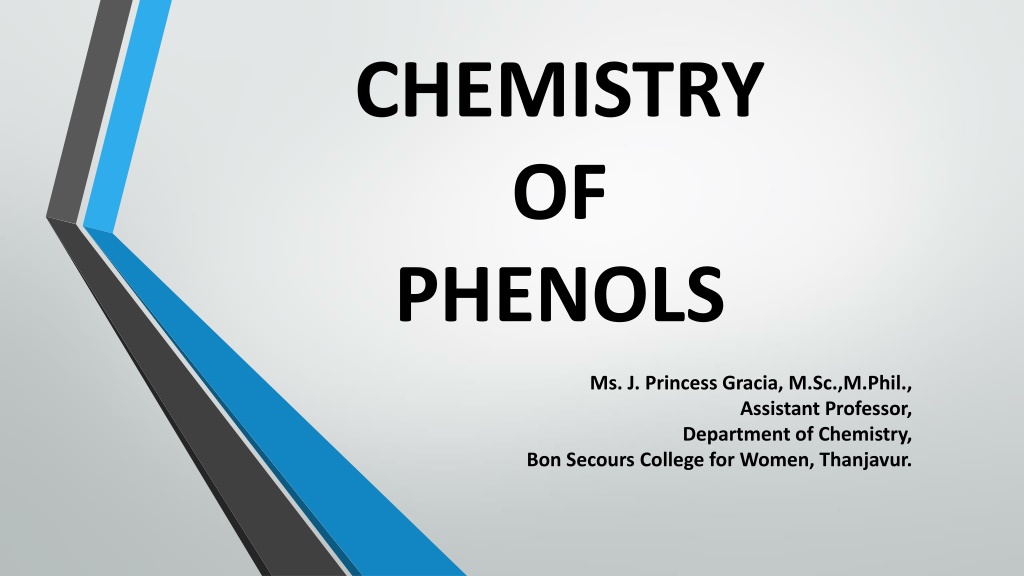
Chemistry of Phenols and their Properties
Discover the chemistry of phenols, including their structure, classification, and methods of preparation. Learn about the physical properties of phenols and their significance in industrial and biological processes. Explore the synthesis of phenols from haloarenes, benzene sulfonic acid, diazonium salts, and cumene. Understand the unique characteristics of phenolic compounds and their applications in various fields.
Download Presentation

Please find below an Image/Link to download the presentation.
The content on the website is provided AS IS for your information and personal use only. It may not be sold, licensed, or shared on other websites without obtaining consent from the author. If you encounter any issues during the download, it is possible that the publisher has removed the file from their server.
You are allowed to download the files provided on this website for personal or commercial use, subject to the condition that they are used lawfully. All files are the property of their respective owners.
The content on the website is provided AS IS for your information and personal use only. It may not be sold, licensed, or shared on other websites without obtaining consent from the author.
E N D
Presentation Transcript
CHEMISTRY OF PHENOLS Ms. J. Princess Gracia, M.Sc.,M.Phil., Assistant Professor, Department of Chemistry, Bon Secours College for Women, Thanjavur.
Introduction- Phenols also called as phenolics are a class of chemical compounds consisting of a hydroxyl group (-OH) bonded directly to an aromatic hydrocarbon group. The simplest of the class is phenol C6H5OH. Phenolic compounds are classified as simple phenols or polyphenols based on the number of phenol units in the molecule. Phenols are synthesized industrially and produced by plants and micro organisms , with variation between and within species.
PREPARATION OF PHENOLS FROM HALOARENES chlorobenzene is an example of haloarenes which is formed by the mono substitution of benzene ring. when chlorobenzene is fused with sodium hydroxide at 623K and 320 atm sodium phenoxide is produced. Finally ,sodium phenoxide on acidification gives phenols.
FROM BENZENE SULPHONIC ACID - Benzene sulphonic acid can be obtained from benzene by reacting it with oleum. Benzene sulphonic acid thus formed is treated with molten sodium hydroxide at high temperature which leads to the formation of sodium phenoxide on acidification gives phenols.
FROM DIAZONIUM SALTS When an aromatic primary amine is treated with nitrous (NaNO2 + HCL ) acid at 273 278 k , diazonium salts are highly reactive in nature.upon warming with water , these diazonium salts hydrolyze to phenols. Phenols can also be obtained from diazonium salts by treating it with dilute acids.
FROM CUMENE Cumene is an organic compound obtained by Friedel crafts alkylation of benzene with propylene. upon oxidation of cumene (isopropyl benzene) in the presence of air , cumene hydroperoxide is obtained. Upon further treatment of cumene hydroperoxide with dilute acid , phenols are obtained. Acetone is also produced as one of the by- products of this reaction in large quantities by these methods need purifications.
PHYSICAL PROPERTIES- They are colorless liquids or crystalline solids but become colored due to slow oxidation with air. Due to the presence of strong intermolecular hydrogen bonding , phenols have a higher boiling point than the corresponding hydrocarbon or aryl haildes. Due to their ability to form hydrogen bonds with water , phenols are moderately soluble in H2O. They are acidic in nature and stronger acids than alcohols. This is due to the fact Sp2 hybridized carbon of phenol to which OH is attached, is highly electronegative which causes a decrease in electron density on oxygen.
REACTIONS OF PHENOL INVOLVING THE CLEAVAGE OF O-H BOND KOLBE S REACTION
NITRATION REACTION WITH DIL.HNO3:
HALOGENATION BROMINATION IN SOLVENTS OF LOW POLARITY LIKE CS2 :
USES- The main use of phenol is as precursors for plastics Phenol is also a useful precursor to a huge collection of drugs, most notablyaspirin but also several herbicides and pharmaceutical drugs. Phenol is an element in liquid / liquid phenol chloroform abstraction technique used in molecular biology for procurement of nucleic acids from tissues or cell culture samples. It is used as an antiseptic It is used as a disinfectant in household cleaners. It is used in the preparation of resins , dyes, explosives, lubricants , pesticides etc.






















